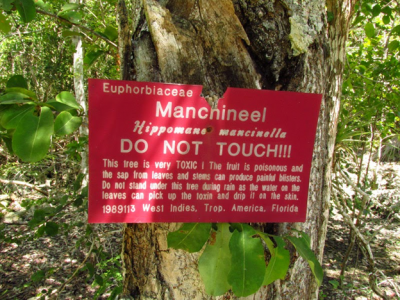
The Manchineel Tree is deemed to be the world’s most dangerous tree by the Guinness Book of World Records. The first part of its scientific name, Hippomane mancinella was coined by the Greek philosopher Theophrastus, where Hippo translates to a horse and mane is derived from mania or madness. Theophrastus conjured this description after he noticed that horses became “deranged” after eating from a native tree. Linnaeus, the father of taxonomy classified this atrocious tree in the same way.
Nicola H Strickland, a consultant radiologist, found its green fruit scattered amongst coconuts and mangoes on an idyllic beach in Tobago. A manchineel tree’s fruit closely resembles an apple and is often called a “beach apple”. She recalls that the fruit fell from a “large tree with a silver bole and oblique based leaves.” She and her friend decided to take a bite.
The manchineel tree belongs to the family of spurges. It is native to Central America, Mexico and Southern Florida. The tree grows along the coastal beaches of the West Indies and in saline waters with mangroves. However, the tree isn’t as abundant or as commonly encountered as the mangrove. On the contrary, it is highly endangered.
The tree assumes the appearance of a tall shrub but can grow to towering heights of up to 50 feet. The bark is reddish to grayish brown and is highly rugged. Any forager can easily mistake its fruit for an apple or guava. However, the toxicity is not limited to its fruits, but includes the whole tree itself! One paper claimed that all its parts are extremely poisonous!
Spanish-speaking countries call it the arbol de la muerte, which translates to “tree of death”. The tree secretes a thick, milky sap that oozes out of its leaves, bole and fruits. Contact with this sap results in severe blistering and inflammation of the skin. Consumption of its succulent fruits or leaves can lead to fatal esophageal ulcers and edema. Also, smoke from its burning wood or rubbing your eyes after handling its leaves can cause temporary blindness.
Credit : Science ABC
Picture Credit : Google




